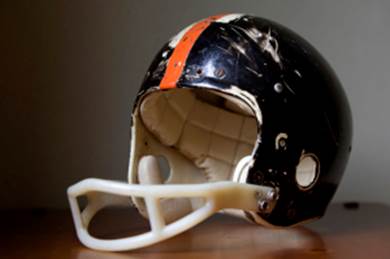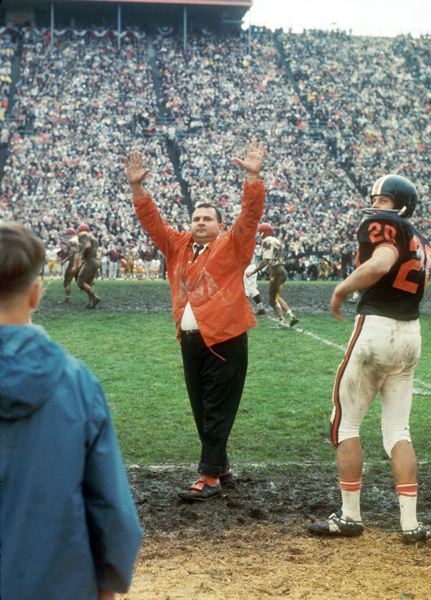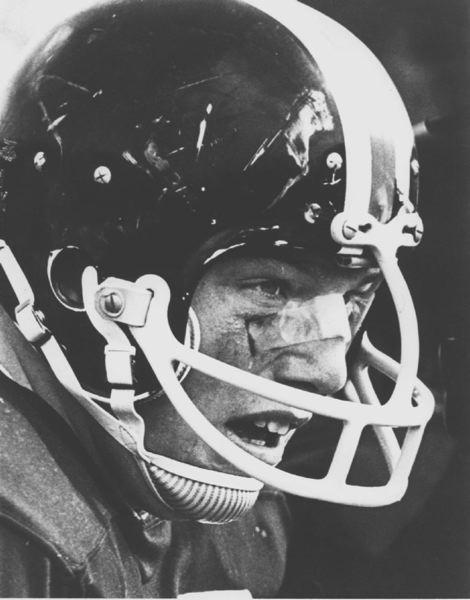HELMET HUT
NEWS/REFLECTIONS July 2017:
"OREGON STATE'S GIANT
KILLERS OF 1967"
By Dr. Ken
In many past columns, I expressed my early passion for football and especially college football. After getting a very early start playing tackle football on the concrete streets of Brooklyn and treating parked cars as opposing tacklers, it was a pleasure “graduating” to the grass covered traffic malls in the middle of Park Avenue in Long Beach or the beach in Point Lookout. Co-conspirator and college football fanatic Rich Landsman and I would compare our burgeoning knowledge each Monday after scouring the sports section and nationwide football scores from the Sunday New York Times. As the first in my family to graduate from high school and also to then attend college, I was rather naïve for a street-smart guy in any area that touched upon the sphere of intellectual activity. I have frequently noted that I was far from prepared to attend college, either academically or socially. I had the grades but not the study habits or organizational skills necessary to succeed in the classroom. I remained the fellow who sat in the last row of each class, did not dress as well as everyone else, and had little or nothing to say when not on the field or lifting weights at the downtown YMCA dungeon of a weight room. I also did not realize that a college library had newspapers from other major cities and thus a world of college and professional football information that was otherwise not available on a daily or weekly basis. My new world included an even deeper descent in to the accumulation of facts, figures, and information. Southwest Conference and West Coast football, as obvious examples became realities that I could follow and in 1967, I became acutely aware of the Oregon State “Giant Killers” of Dee Andros perhaps before most of the nation’s sportswriters did.
A game worn Rawlings helmet with a rare, curved plastic mask from the Dee Andros years at Oregon State
I knew a few things about Andros and his background because I had an attraction to and accumulated knowledge of Bud Wilkinson’s great Oklahoma teams. The Oklahoma City raised son of Greek immigrants, Demosthenes Konstandies Andrecopoulos, which perhaps explains the Americanization of the name to Dee Andros, was one of Wilkinson’s star linemen after serving as a teenage U.S. Marine combat veteran and Bronze Star medal winner. He witnessed the raising of the American flag at Mount Suribachi at the Battle of Iwo Jima and was awarded his service medal after a solid month under enemy fire. As a heavy-set, animated, very quotable, motivating coach who was usually clad in OSU Beaver orange, he had earned the moniker of “The Great Pumpkin” and thus was one of the game’s leaders I was quite aware of. He also coached two tough guy players I enjoyed following, linebacker Jack “Mad Dog” O’Billovich [ see HELMET HUT NEWS/REFLECTIONS, March 2011; http://www.helmethut.com/Features/Dr.Ken89.html ] and fullback Pete Pifer who had two consecutive 1000 yard seasons.
Dee Andros, obviously The Great Pumpkin!
The 1967 OSU squad was a typical Andros blue collar contingent well suited to running his stick-it-down-your-throat Power T Offense, a pounding running attack with a noticeable lack of passing statistics. Under Tommy Prothro who took the helm at Corvallis in 1955, the primarily home grown squad of tough hewn farm boys won consistently and punctuated the respect earned from opponents with a Rose Bowl appearance after the ’56 season and Heisman Trophy winner Terry Baker in 1962. Andros arrived in ’65 from his head coaching position at Idaho and continued a similar type of success established by Prothro with 5-5 and 7-3 records in his first two seasons. Then came 1967 and a twenty-one day journey that made the term “Giant Killers” forever synonymous with the Beavers squad that had many solid players, few superstars, and an absence of superstar types and attitudes. They captured the nation’s attention by entering their three-week march by traveling to West Lafayette, Indiana as nineteen point underdogs and defeating number two ranked Purdue, led by the next year’s Heisman runner-up Leroy Keyes. After a 35 – 7 victory over Washington State, they took on the country’s newly minted number two ranked UCLA squad led by ’67 Heisman winner Gary Beban and coached by their former mentor Tommy Prothro. The Beavers outplayed the Bruins but settled for a game tying field goal with a minute remaining to walk away with a score of 16 – 16.
After this game, Andros made what became a quotable line for some time to follow, one he later noted, was made from the well of enthusiasm and not conceit, "We're tired of foolin' around with number two, bring on number one!" College football fans will recall that 1967’s number one team for much of the season and in the final rankings, was the future-pro-player-dotted University of Southern California Trojans. They will also recall their ’68 Heisman Trophy winning tailback O.J. Simpson. Although Oregon State had risen to some notice with a national rank of thirteen due to their Purdue and UCLA performances, the Trojans remained solid eleven point favorites. The Beavers were stout with center John Didion, quarterback Steve Preece, linebacker Skip Vanderbundt, and fast-rising fullback Bill “Earthquake” Enyart who had been converted from linebacker for his junior season but USC viewed this as just another game. A record crowd including California Governor Ronald Reagan and Oregon Governor Tom McCall were in attendance as the OSU home Parker Stadium field quickly became a quagmire in the Northwest rain. Oregon State’s usually tough defense played a bend-but-don’t-break game while Vanderbundt and All American tackle Jess Lewis, a ’68 U.S. Olympian wrestler, proved to be indefatiguable. Despite accumulating 188 rushing yards, O.J. could not find the end zone and the muddy mess limited passing yardage to eight for the home team and but six for the mighty Trojans! Mike Haggard’s second quarter field goal proved to be the lone points of the game as the upset of the season went to the Beavers and solidified the legend of “The Giant Killers.” With the USC squad finishing 1967 with the National Championship and a 10 – 1 mark, the loss to Oregon State was even further emphasized.
OJ Simpson and the Number One ranked Trojans went down against The Giant Killers
Many grudgingly gave OSU respect for their three week run but others refused to accept that they could stand toe-to-toe with the mighty USC champions and defeat them legitimately. The condition of the field received a great deal of attention, the implication being that if the rain-soaked mudbowl had offered reasonable footing to the great USC stars, the contest’s conclusion could have gone as predicted. USC head coach John McKay complained long and loudly about the field conditions and Trojan Athletic Director Jess Hill pushed for an immediate conference rule that home teams had to cover their fields on game day mornings if there was any chance of precipitation. Governor Reagan chimed in, offering to donate the first dollar to a fund that would allow the Beavers to install Astro Turf, and a group of Trojan boosters quickly came up with $15,000.00 to purchase a new tarp for Parker Field. USC nose guard and future Oakland Raider hippie linebacker Ralph “Chip” Oliver called the game “a real disaster. It had been raining so hard up there that the field was just unbelieveable, and they had the band out marching on it before the game so the place was really sloshed up. All we did was slide around in the mud for two hours. It was not exactly the perfect place for O.J. to break away. The big Oregon State guards made my own quickness and agility useless, and alI I could do was try to pile it up the best I could.” Unfortunately, another victory over the Trojans wouldn’t come until September 30, 2000.
The team oriented Beavers completed their season with a 14 – 10 Civil War victory over rival Oregon to finish the season at 7 – 2 – 1 and a final national rank of seventh place but as was the standard procedure for the era, there was no Rose Bowl game with the 10 – 1 Trojans taking that slot and there was a conference prohibition from bowl participation other than the Rose Bowl. The absence of a Rose Bowl appearance has not prevented the 1967 Oregon State team from becoming part of the fabric of Beavers lore. Fullback Bill Enyart who had been an All Conference linebacker as a sophomore, was a First Team All American and was voted into the College Football Hall of Fame; defensive tackle Jess Lewis was a First Team All American, NCAA Heavyweight Wrestling Champion, and 1968 Olympian; center John Didion was a Second Team All American in ’67,Unanimous First Team All American in ’68 and like Lewis, on the ballot for the 2018 College Football Hall of Fame entry list. He spent two seasons playing linebacker for the Redskins before returning to his more natural center position for the Saints from ’71 through 1974 and was part of the trade that brought Billy Kilmer to Washington. Captain and Defensive MVP, William “Skip” Vanderbundt was also a Beavers baseball letterman, was named a Second Team All American, and played a ten year NFL career, all but his last with the Forty Niners. Quarterback Steve Preece, the Giant Killers MVP and again in ’68, managed to tack together a nine season NFL career with five teams and later was an OSU radio analyst, while guard Rocky Rasley, often an overshadowed and little recalled squad member, had an eight year NFL career and who like Lewis, was an outstanding wrestler. He finished in sixth place at the 1969 World Championship. Quiet giant Jon Sandstrom was a three year starter and a 1968 First Team All American and later spent time with Winnepeg of the CFL. Although he did not play pro ball after being drafted by the Steelers, halfback Billy Main, at times appearing half the size of fullback “Buffalo/Earthquake” Enyart, provided the effective blocking for his running mate and was an inspiration as a two-time Second Team All Conference choice and the holder of many OSU records that stood for decades.
Tough, reliable fullback Bill Enyart asked to help the team at fullback after an All Conference sophomore year at linebacker.
A terrific documentary film has been produced about the 1967 Oregon State football team, “Legend Of The Giant Killers”
[ see https://www.facebook.com/legendofthegiantkillers/ ] and it is a testament not only to the achievement of those players and coaches, but an explanation of the team’s importance to the campus community. Filmmaker Alex Crawford, a young radio sports programming producer and Oregon State alumnus stated that he asked “a question in our original interviews… 'Do you think one game can define a season, and do you think one season can define a program?'" The Giant Killers of ’67 produced a bit of obscure history by being the only college team to go unbeaten against three nationally ranked Top Three squads in one season and of course, they accomplished that in a rather compressed period of days. Crawford further stated that "The ethos of Oregon State that's represented by the Giant Killers is that we're going to outwork you and we're going to out-tough you. You might have O.J. Simpson, the best running back in college football, but our field is muddy, and we're going to get down in the trenches. We're going to go to work.” This of course was the personification of OSU football and the teams of Dee Andros; never the top recruits, never the best talent, and never anything fancy, the wins will come and they did come, with hard work, teamwork, and toughness. The Giant Killers squad was inducted into the OSU Athletic Hall Of Fame paying homage to a footnote for most college football fans but an important and ongoing motivator in Corvallis, Oregon.





